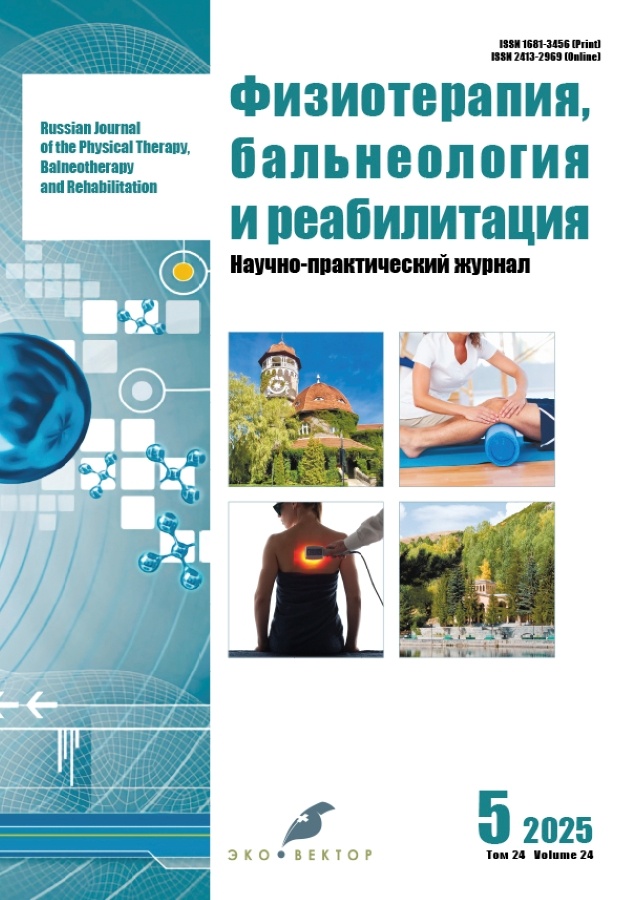Fractional laser photothermolysis for early correction of ecchymoses: development of an effective therapeutic protocol
- Authors: Shamsutdinova D.S.1, Ponomarenko I.G.2, Ponomarenko G.N.1,2, Platonova A.V.3
-
Affiliations:
- Federal Scientific and Aducational Centre of Medical and Social Expertis and Rehabilitation n. a. G.A. Albrecht
- North-Western State Medical University named after I.I. Mechnikov
- Kirov Military Medical Academy
- Issue: Vol 24, No 5 (2025)
- Pages: 383-390
- Section: Original studies
- Published: 27.08.2025
- URL: https://rjpbr.com/1681-3456/article/view/686665
- DOI: https://doi.org/10.17816/rjpbr686665
- EDN: https://elibrary.ru/GERGGJ
- ID: 686665
Cite item
Abstract
BACKGROUND: The correction of ecchymoses remains a pressing issue in dermatology and esthetic medicine. Persistent skin discoloration caused by hemoglobin breakdown (oxyhemoglobin → deoxyhemoglobin → methemoglobin → biliverdin → bilirubin → hemosiderin) leads to psychological discomfort for patients and prolongs rehabilitation after trauma, surgery, or invasive procedures. The limited effectiveness of conventional approaches (topical heparin-containing agents, cold/heat therapy) highlights the need for physical technologies to accelerate hematoma resolution.
AIM: The work aimed to provide scientific and practical justification for the use of fractional CO₂ laser photothermolysis (10,600 nm) with an optimized L-shaped pulse in patients with ecchymoses and to develop an effective therapeutic protocol.
METHODS: It was a prospective comparative study of the efficacy and safety of fractional CO₂ laser photothermolysis for ecchymosis correction. The study included 25 patients with post-traumatic or postoperative ecchymoses of 1–5-day duration, divided into the observation group (laser therapy, n = 15) and the reference group (conventional therapy, n = 10). Parameters: CO₂ laser (10,600 nm) operated in fractional photothermolysis mode with L-shaped pulse, power 6–8 W, microthermal zone density 400–500 dots/cm², 1 pass, pulse duration 500–600 µs. Trends were assessed using photographic documentation, colorimetric scales, and videodermoscopy.
RESULTS: The laser therapy group showed a pronounced positive response: resolution time was reduced by 40%–50% (mean 5 ± 1.8 days vs. 14 ± 2.3 days in the reference group; p < 0.05). Accelerated transition from blue-purple to yellow coloration was observed (by days 3–4), with minimal risk of residual pigmentation. The overall efficacy reached 85% (marked improvement). The safety profile was high: 20% of patients showed mild transient erythema, which resolved within 24 hours.
CONCLUSION: Fractional CO₂ laser photothermolysis with an L-shaped pulse is an effective method for early correction of ecchymoses, providing targeted ablation of pigmented epidermis and stimulation of lymphatic drainage. Optimized parameters (6–8 W, 400–500 MTZ/cm², 500–600 µs, 1 pass) ensure controlled impact on hemoglobin breakdown products without risk of damaging surrounding intact tissues.
Full Text
About the authors
Diana S. Shamsutdinova
Federal Scientific and Aducational Centre of Medical and Social Expertis and Rehabilitation n. a. G.A. Albrecht
Email: prokt57@mail.ru
ORCID iD: 0009-0007-1759-9995
Russian Federation, Saint Petersburg
Inga G. Ponomarenko
North-Western State Medical University named after I.I. Mechnikov
Author for correspondence.
Email: manga-85@mail.ru
ORCID iD: 0000-0001-6550-6940
SPIN-code: 7930-2463
MD, Dr. Sci. (Medicine), Professor
Russian Federation, Saint PetersburgGennady N. Ponomarenko
Federal Scientific and Aducational Centre of Medical and Social Expertis and Rehabilitation n. a. G.A. Albrecht; North-Western State Medical University named after I.I. Mechnikov
Email: ponomarenko.gn@gmail.com
ORCID iD: 0000-0001-7853-4473
SPIN-code: 8234-7005
MD, Dr. Sci. (Medicine), Professor
Russian Federation, Saint Petersburg; Saint PetersburgAnna V. Platonova
Kirov Military Medical Academy
Email: platonova1105@gmail.com
ORCID iD: 0000-0001-7143-8411
SPIN-code: 5609-9713
MD, Cand. Sci. (Medicine)
Russian Federation, Saint PetersburgReferences
- Kryukov VN, Sarkisyan BA, Yankovskiy VE, et al. Diagnostic Guide to the Mechanisms and Morphology of Soft Tissue Injuries in Blunt Trauma. Vol. 6: Mechanisms and Morphology of Soft Tissue Injuries. Novosibirsk: Nauka; 2001. 142 p. (In Russ.)
- Nesterov MA. Changes in bruise coloration resulting from therapeutic interventions. Selected Issues of Forensic Medical Examination. In: Selected Issues of Forensic Medical Examination: Materials of Scientific Research by the Departments of Forensic Medicine in Khabarovsk, Vladivostok, the Bureau of Forensic Medical Examination in the Far East, Birobidzhan, and the Khabarovsk Laboratory of Forensic Examinations, Khabarovsk, April 10–11, 2001. Vol. 4. Khabarovsk: Far Eastern State Medical University; 2001: 43–45. (In Russ.) EDN: URKAMC
- Karimi S, Sadeghi M, Amali A, Saedi B. Effect of Photobiomodulation on Ecchymosis after Rhinoplasty: A Randomized Single-Blind Controlled Trial. Aesthetic Plastic Surgery. 2020;44(5):1685–1691. doi: 10.1007/s00266-020-01760-9
- Siperstein R, Wikramanayake TC. Intense Pulsed Light as a Treatment for Senile Purpura: A Pilot Study. Lasers in Surgery and Medicine. 2021;53(7):926–934. doi: 10.1002/lsm.23358
- Tsunoda Y, Kono T, Imagawa K, et al. Treatment of Ecchymosis with a Pulsed Dye Laser. Tokai Journal of Experimental and Clinical Medicine. 2023;48(4):144–145.
- Verner I, Prag Naveh H, Bertossi D. Treatment of injection-induced ecchymoses with light/laser-assisted technology. Dermatologic Therapy. 2019;32(3):e12861. doi: 10.1111/dth.12861
- Babilas P, Schreml S, Szeimies RM, Landthaler M. Intense pulsed light (IPL): a review. Lasers in Surgery and Medicine. 2010;42(2):93–104. doi: 10.1002/lsm.20877
- Monakhov SA, Korchazhkina NB, Olisova OYu. Narrow-wave phototherapy 311 nm in the treatment of patients with atopic dermatitis. Russian Journal of Skin and Venereal Diseases. 2012;(3):25–27. EDN: PFBPCL
- Monakhov SA, Perminova MA, Shabliy RA, Korchazhkina NB, Olisova OYu. Phototherapy methods in the treatment and prevention of chronic dermatoses. Problems of Balneology, Physiotherapy, and Exercise Therapy. 2012;89(4):33–36. EDN: NQXUSI
- Oram Y, Akkaya AD. Refractory Postinflammatory Hyperpigmentation Treated Fractional CO2 Laser. Journal of Clinical and Aesthetic Dermatology. 2014;7(3):42–44.
- Zhang DD, Zhao WY, Fang QQ, et al. The efficacy of fractional CO2 laser in acne scar treatment: A meta-analysis. Dermatologic Therapy. 2021;34(1):e14539. doi: 10.1111/dth.14539
- Al Janahi S, Lee SJ, McGee JS, Chung HJ. Hypertrophic Scar After Treatment of Ecchymoses with Pulsed-Dye Laser. Dermatologic Surgery. 2020;46(6):851–853. doi: 10.1097/DSS.0000000000001907
- Lederhandler MH, Bloom BS, Pomerantz H, Geronemus RG. Case Series of Fractional Ablative Laser Resurfacing of Pediatric Facial Traumatic and Surgical Scars. Lasers in Surgery and Medicine. 2021;53(1):50–54. doi: 10.1002/lsm.23282
- Pilling ML, Vanezis P, Perrett D, Johnston A. Visual assessment of the timing of bruising by forensic experts. Journal of Forensic and Legal Medicine. 2010;17(3):143–149. doi: 10.1016/j.jflm.2009.10.002
- Zhao S, Wang M, Lai X, Yan Y. Efficacy and Safety of Ablative Fractional Laser in Melasma: A Meta-analysis and Systematic Review. Lasers in Medical Science. 2024;39(1):71. doi: 10.1007/s10103-024-03972-w
Supplementary files
















